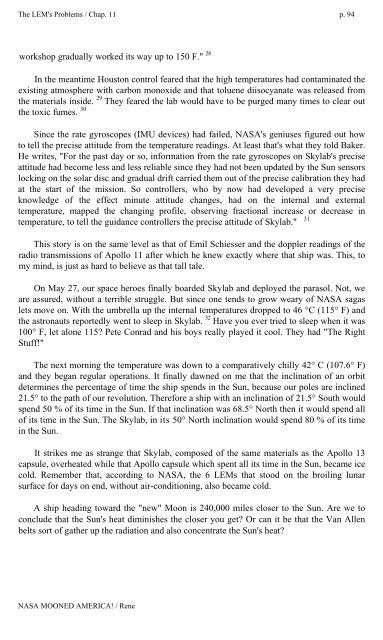Rene-NASA-Mooned-America
Rene-NASA-Mooned-America
Rene-NASA-Mooned-America
Create successful ePaper yourself
Turn your PDF publications into a flip-book with our unique Google optimized e-Paper software.
The LEM's Problems / Chap. 11 p. 94<br />
workshop gradually worked its way up to 150 F." 28<br />
In the meantime Houston control feared that the high temperatures had contaminated the<br />
existing atmosphere with carbon monoxide and that toluene diisocyanate was released from<br />
the materials inside. 29 They feared the lab would have to be purged many times to clear out<br />
the toxic fumes. 30<br />
Since the rate gyroscopes (IMU devices) had failed, <strong>NASA</strong>'s geniuses figured out how<br />
to tell the precise attitude from the temperature readings. At least that's what they told Baker.<br />
He writes, "For the past day or so, information from the rate gyroscopes on Skylab's precise<br />
attitude had become less and less reliable since they had not been updated by the Sun sensors<br />
locking on the solar disc and gradual drift carried them out of the precise calibration they had<br />
at the start of the mission. So controllers, who by now had developed a very precise<br />
knowledge of the effect minute attitude changes, had on the internal and external<br />
temperature, mapped the changing profile, observing fractional increase or decrease in<br />
temperature, to tell the guidance controllers the precise attitude of Skylab." 31<br />
This story is on the same level as that of Emil Schiesser and the doppler readings of the<br />
radio transmissions of Apollo 11 after which he knew exactly where that ship was. This, to<br />
my mind, is just as hard to believe as that tall tale.<br />
On May 27, our space heroes finally boarded Skylab and deployed the parasol. Not, we<br />
are assured, without a terrible struggle. But since one tends to grow weary of <strong>NASA</strong> sagas<br />
lets move on. With the umbrella up the internal temperatures dropped to 46 °C (115° F) and<br />
the astronauts reportedly went to sleep in Skylab. 32 Have you ever tried to sleep when it was<br />
100° F, let alone 115 Pete Conrad and his boys really played it cool. They had "The Right<br />
Stuff!"<br />
The next morning the temperature was down to a comparatively chilly 42° C (107.6° F)<br />
and they began regular operations. It finally dawned on me that the inclination of an orbit<br />
determines the percentage of time the ship spends in the Sun, because our poles are inclined<br />
21.5° to the path of our revolution. Therefore a ship with an inclination of 21.5° South would<br />
spend 50 % of its time in the Sun. If that inclination was 68.5° North then it would spend all<br />
of its time in the Sun. The Skylab, in its 50° North inclination would spend 80 % of its time<br />
in the Sun.<br />
It strikes me as strange that Skylab, composed of the same materials as the Apollo 13<br />
capsule, overheated while that Apollo capsule which spent all its time in the Sun, became ice<br />
cold. Remember that, according to <strong>NASA</strong>, the 6 LEMs that stood on the broiling lunar<br />
surface for days on end, without air-conditioning, also became cold.<br />
A ship heading toward the "new" Moon is 240,000 miles closer to the Sun. Are we to<br />
conclude that the Sun's heat diminishes the closer you get Or can it be that the Van Allen<br />
belts sort of gather up the radiation and also concentrate the Sun's heat<br />
<strong>NASA</strong> MOONED AMERICA! / <strong>Rene</strong>


